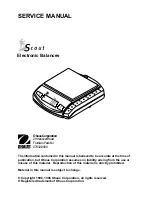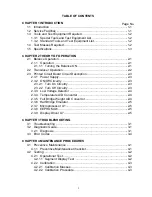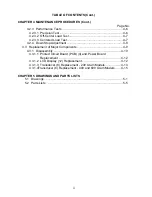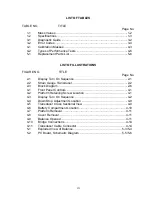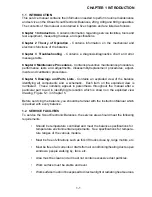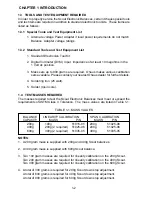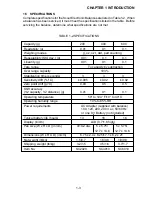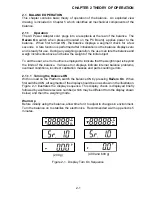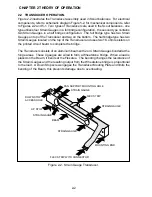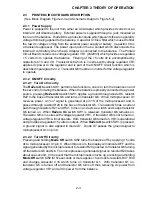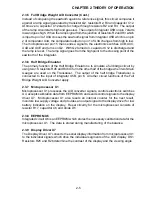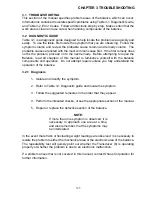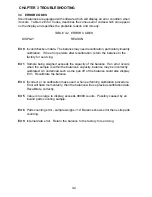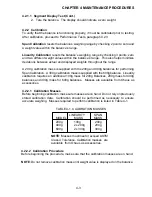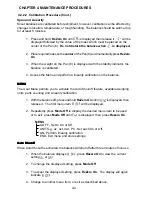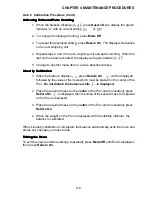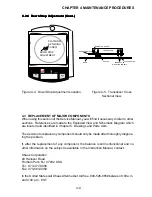
2-4
CHAPTER 2 THEORY OF OPERATION
2.3.3 Low Voltage Detector
The purpose of the Low Voltage Detector circuitry is to inform an operator when the
battery voltage drops to level which would cause improper operation of the balance and
require replacement of the battery. Transistors Q4 and Q7 form the low voltage
detector. Transistor Q3 is turned on as long as the voltage across VR1 pins 1 and 3 is
higher than the emitter base voltage (0.6 V) of Q4. With a low voltage, Q4 turns off, so
does Q7. The result is that the VLOW signal at pin 3 of Q7 goes high placing a high state
at pin 7 of microprocessor U1. The microprocessor U1 then sends a corresponding
signal to driver U7 which is the word equivalent of BAT. This data is then sent to the
display DS1 where the word BAT is displayed.
2.3.4 Temperature A/D Converter
The primary function of the Temperature A/D Converter is to compensate for tempera-
ture changes of the Transducer during operation. It does this by converting the varying
dc analog voltages developed by the temperature sensor to a digital signal which is
directly proportional to the analog voltages and represents temperature. The tempera-
ture sensor is physically located on the Transducer. A current signal developed by the
temperature sensor is referenced to ground and is applied to the junction of resistors R9
and R10 to the input pin 2 of U5A which is an integrator. A reference voltage is developed
by resistors R4 and R5 (from the 5 volt source to ground) to pin 5 of U3B which is a
comparator and pin 3 of U5A which is an integrator. The current through the
temperature sensor is measured by the duty cycle of resistor R11 which is switched from
+5 volts dc and ground by U4A and U4F which act as electronic switches. The duty cycle
determines how much current is pulled out in this mode and how much is fed in. A signal
from the microprocessor U1 pin 17 provides a duty cycle ranging from 10 to 30% to pin
1 of U4A. U5A is an integrator which develops a sawtooth signal output which is
compared with the 1 volt reference signal by U3B comparator. When the sawtooth
signal from U5A at pin 1 is on the down slope and crosses the 1 volt reference point,
comparator U3B outputs a low signal to the microprocessor pin 27 through resistor R43.
The microprocessor interprets this signal as a value of current which is representative
of the temperature of the temperature sensor on the Transducer. The microprocessor
then sends a signal on pin 17 to pin 4 of U4A and pin 13 of U4F which are the electronic
switches. This square wave signal reverses the switching action and starts a new
integration of U5A.
2.3.5 Full Bridge Weight A/D Converter
The primary function of the Full Bridge Weight A/D Convertor is to convert the varying
dc analog voltages developed by a full bridge type Transducer to a digital signal which
is directly proportional to the analog voltages. This signal is then processed by
microprocessor U1. The circuitry consists of integrator U5B, comparator U3A, elec-
tronic switches U4A, U4B, U4C, and U4D with resistors R1, R2, R3, R7, R14, R34, R35,
capacitors C1, C3, C12, C19 and transistor Q2. The circuitry functions in a similiar
manner as the Temperature A/D Converter except a duty cycle of 10 to 90% is achieved.
The output of a full wave bridge Transducer is through resistor R13 to pin 6 of U5B. The
output of U5B is a sawtooth signal which is connected to U3A, pin 2.
Summary of Contents for SCOUT
Page 1: ...OhausCorporation 29HanoverRoad FlorhamPark NJ 07932 0900 ELECTRONIC BALANCES SERVICE MANUAL TM...
Page 6: ...i v...
Page 10: ...1 4 CHAPTER 1 INTRODUCTION...
Page 38: ...5 2 CHAPTER 5 DRAWINGS AND PARTS LISTS...
Page 39: ...5 3 CHAPTER 5 DRAWINGS AND PARTS LISTS Figure 5 1 Exploded View of Balance 5 3 5 4...
Page 43: ...SCOUT ELECTRONIC BALANCES P N 300040 010 R1198...
Page 45: ...e e e...
Page 47: ......


